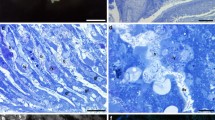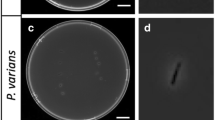Abstract
Invertebrates harbouring endosymbiotic chemoautotrophic bacteria are widely distributed in a variety of reducing marine habitats, including deep-sea hydrothermal vents. Bathymodiolids are dominants of the biomass at geochemically distinct vent sites of the Mid Atlantic Ridge (MAR) and thus are good candidates to study biological processes in response to site-specific conditions. To satisfy their nutritional requirements, these organisms depend to varying extent on two types of chemoautotrophic symbionts and on filterfeeding. The quantitative relationships of the nutritional modes are poorly understood. Using enzyme cytochemistry, electron microscopy and X-ray microanalysis, the structural and functional aspects of the cellular equipment necessary for lysosomal digestion was studied. We provide evidence for the following: (1) the basis of intracellular digestion of symbionts in Bathymodiolus azoricus from two geochemically distinct vent sites was not mainly in the large lysosomal bodies as previously thought (based on the membranous content resembling bacteria); (2) senescent bacteria are autolysed, possibly by bacterial acid phosphatase, that is more likely a cell cycling of the symbionts rather than an active lysosomal digestion by the host; (3) the consistent absence of hydrolases may indicate the improper use of the name “lysosome” for large vesicles at the base of the gill bacteriocytes (4) nutrient transfer in B. azoricus, therefore, may more likely be accomplished through leaking of metabolites from the symbiont to the host, not excluding lysosomal resorption of dead bacteria as an auxiliary strategy for organic molecule transfer; (5) evidence is provided for microvillar transfer of substances from the seawater that may indicate filter-feeding, in non-symbiotic ciliated gill cells of mussels from Lucky Strike; (6) two types of lysosomal vesicles can be distinguished in digestive cells based on their enzymatic content and their elemental composition.





Similar content being viewed by others
References
Charlou JL, Donval JP, Douville E, Jean-Baptiste P, Radford-Knoery J, Fouquet Y, Dapoigny A, Stievenard M (2000) Compared geochemical signatures and the evolution of Menez Gwen 37 degrees 50′N and Lucky Strike 37 degrees 17′N hydrothermal fluids, south of the Azores Triple Junction on the Mid-Atlantic Ridge. Chem Geol 171:49–75
Chassard-Bouchaud C, Fiala-Medioni A, Galle P (1986) Etude microanalytique de Bathymodiolus sp. (Mollusque Lamellibranche, Mytilidae) provenant des sources hydrothermales de la Ride du Pacifique oriental. Donnee preliminaire. Comptes Rendus de l’Academie des Sciences, Paris (Ser III) 302:117–124
Desbruyeres D, Biscoito M, Caprais JC, Colaco A, Comtet T, Crassous P, Fouquet Y, Khripounoff A, Le Bris N, Olu K, Riso R, Sarradin PM, Segonzac M, Vangriesheim A (2001) Variations in deep-sea hydrothermal vent communities on the Mid-Atlantic Ridge near the Azores plateau. Deep Sea Res Part I Oceanogr Res Pap 48:1325–1346
Distel DL, Felbeck H (1987) Endosymbiosis in the lucinid clams Lucinoma aequizonata, Lucinoma annulata and Lucina floridana—a reexamination of the functional–morphology of the gills as bacteria-bearing organs. Mar Biol 96:79–86
Dubilier N, Windoffer R, Giere O (1998) Ultrastructure and stable carbon isotope composition of the hydrothermal vent mussels Bathymodiolus brevior and B. sp. Affinis brevior from the North Fiji Basin, western Pacific. Mar Ecol Prog Ser 165:187–193
Fankboner PV (1971) Intracellular digestion of symbiotic zooxantelae by host amoebocytes in giant clams (Bivalvia: tridacnidae), with note on the nutritional role of the hypertrophied siphonal epidermis. Biol Bull 141:222–234
Fiala-Medioni A, Metivier C, Herry A, Lepennec M (1986) Ultrastructure of the gill of the hydrothermal-vent Mytilid Bathymodiolus sp. Mar Biol 92:65–72
Fiala-Medioni A, Felbeck H, Childress JJ, Fisher CR Vetter RD (1990) Lysosomic resorption of bacterial symbionts in deep-sea bivalves. In: Nardon P, Gianninazzi-Pearson V, Grenier AM, Margulis L, Smith DC (eds) Endocytobiology IV. Institut National de Recherche Agronomique, Paris
Fiala-Medioni A, Michalski JC, Jolles J, Alonso C, Montreuil J (1994) Lysosomic and lysozyme activities in the gill of bivalves from deep hydrothermal vents. C R Acad Sci (Serie III) 317:239–244
Fiala-Medioni A, McKiness ZP, Dando P, Boulegue J, Mariotti A, Alayse-Danet AM, Robinson JJ, Cavanaugh CM (2002) Ultrastructural, biochemical, and immunological characterization of two populations of the mytilid mussel Bathymodiolus azoricus from the Mid-Atlantic Ridge: evidence for a dual symbiosis. Mar Biol 141:1035–1043
Fisher CR, Brooks JM, Childress JJ, Felbeck H, Hessler RR, Johnson KS, Macko SA, Moe A, Nelson D, Somero GN (1989) Microhabitat requirements of the hydrothermal vent mussel, Bathymodiolus thermophilus. Am Zool 29:A81–A81
Gustafson RG, Turne RD, Lutz RA, Vrijenhoek RC (1998) A new genus and five new species of mussels (Bivalvia, Mytilidae) from deep-sea sulphide/hydrocarbon seeps in the Gulf of Mexico. Malacologia 40:63–112
Holtzman E (1989) Lysosomes. Plenum Press, New York
Hopsu-Hovu VK, Arstila AV, Helminen HJ, Kalimo HO (1967) Improvements in method for electron microscopic localisation of arylsulphatase activity. Histochemie 8:54–64
Ishikawa K, Mihara Y, Gondoh K, Suzuki E, Asano Y (2000) X-ray structures of a novel acid phosphatase from Escherichia blattae and its complex with the transition-state analog molybdate. EMBO J 19:2412–2423
Johnson MA, Fernandez C (2001) Bacterial symbiosis in Loripes lucinalis (Mollusca: Bivalvia) with comments on reproductive strategy. J Mar Biol Assoc UK 81:251–257
Johnson KS, Childress JJ, Beehler CL, Yakamoto CM (1994) Biogeochemistry of hydrothermal vent mussel communities—the deep-sea analog to the intertidal zone. Deep Sea Res Part I Oceanogr Res Pap 41:993–1011
Johnson MA, Paulet YM, Donval M, Le Pennec M (1996) Histology, histochemistry and enzyme biochemistry in the digestive system of the endo-symbiont-bearing bivalve Loripes lucinalis (Lamarck). J Exp Mar Biol Ecol 197:15–38
Kadar E, Powell JJ (2006) Post-capture experimental investigations using hydrothermal vent macro-invertebrates to study adaptations to extreme environments. Rev Environ Sci Biotechnol 5:193–201
Kadar E, Bettencourt R, Costa V, Santos RS, Lobo-Da-Cunha A, Dando P (2005) Experimentally induced endosymbiont loss and re-acquirement in the hydrothermal vent bivalve Bathymodiolus azoricus. J Exp Mar Biol Ecol 318:99–110
Kadar E, Santos RS, Lobo-Da-Cunha A, Dando P (2006a) Spermatogenesis of Bathymodiolus azoricus in captivity matching reproductive behaviour at deep-sea hydrothermal vents. J Exp Mar Biol Ecol 335:19–26
Kadar E, Bettencourt R, Lobo-da-Cunha A (2006b) Gamma-proteobacteria detected in the digestive gland of the vent mussel Bathymodiolus azoricus. Cah Biol Mar 47(4):429–434
Kadar E, Costa V, Santos RS, Powell JJ (2006c) Tissue partitioning of micro-essential metals in the vent bivalve Bathymodiolus azoricus and associated organisms (endosymbiont bacteria and parasite polychaete) from geochemically distinct vents of the Mid-Atlantic Ridge. J Sea Res 56:45–52
Kadar E Santos RS, Powell JJ (2006d) Biological factors influencing tissue compartmentalization of trace metals in the deep-sea hydrothermal vent bivalve Bathymodiolus azoricus at geochemically distinct vent sites of the Mid-Atlantic Ridge. Environ Res 101:221–229
Langmuir C, Humphris S, Fornari D, VanDover C, VonDamm K, Tivey MK, Colodner D, Charlou JL, Desonie D, Wilson C, Fouquet Y, Klinkhammer G, Bougault H (1997) Hydrothermal vents near a mantle hot spot: the Lucky Strike vent field at 37 degrees N on the Mid-Atlantic Ridge. Earth Planet Sci Lett 148:69–91
Le Pennec M, Bejaoui NA (2001) The conquest of reduced deep marine ecosystems by mytilid mussels. Bulletin de la Societe Zoologique de France 126:121–127
Le Pennec M, Martinez JC, Donval A, Herry A, Menninger P (1992) Enzimologie du tractus digestif de la modiole hidrotermale Bathymodiolus thermophilus (Mollusque Bivalve) Canadian. J Zoologie 175:2298–2302
Liberge M, Gros O, Frenkiel L (2001) Lysosomes and sulfide-oxidising bodies in the bacetriocytes of Lucina pectinata, a cytochemical and microanalysis approach. Mar Biol 139:401–409
Lobo-da-Cunha A, Batista-Pinto C (2003) Stomach of Aplysia depilans (Mollusca, Opistobranchia): a histochemical, ultrastructural and cytochemical study. J Morphol 256:360–370
Page HM, Fialamedioni A, Fisher CR, Childress JJ (1991) Experimental-evidence for filter-feeding by the hydrothermal vent mussel, Bathymodiolus-thermophilus. Deep Sea Res Part A Oceanogr Res Pap 38:1455–1461
Pasteels JJ (1969) Excretion de phosphate acide par les cellules mucipares de la branchie de Mystiuls edulis L. Z Zellforsch 102:594–600
Pipe RK, Moore MN (1985) The ultrastructural localisation of lysosomal acid hydrolases in developing oocytes of the common marine mussel Mytilus edulis. Histochem J 17:939–949
Pond DW, Bell MV, Dixon DR, Fallick AE, Segonzac M, Sargent JR (1998) Stable-carbon-isotope composition of fatty acids in hydrothermal vent mussels containing methanotrophic and thiotrophic bacterial endosymbionts. Appl Environ Microbiol 64:370–375
Sarradin PM, Caprais JC, Riso R, Kerouel R, Aminot A (1999) Chemical environment of the hydrothermal mussel communities in the Lucky Strike and Menez Gwen vent fields, Mid-Atlantic Ridge. Cah Biol Mar 40:93–104
Streams ME, Fisher CR, Fiala-Medioni A (1997) Methanotrophic symbiont location and fate of carbon incorporated from methane in a hydrocarbon seep mussel. Mar Biol 129:465–476
Vincent JB, Crowder MW, Averill BA (1992) Hydrolysis of phosphate monoesters: a biological problem with multiple chemical solutions. Trends Biochem Sci 17:105–110
Von Cosel R, Olu K (1998) Gigantism in Mytilidae. A new Bathymodiolus from cold seep areas on the Barbados accretionary Prism. C R Acad Sci (Serie III) 321:655–663
Von Cosel R, Comtet T, Krylova EM (1999) Bathymodiolus (Bivalvia: Mytilidae) from hydrothermal vents on the Azores Triple Junction and the Logatchev hydrothermal field, Mid-Atlantic Ridge. Veliger 42:218–248
Yamanaka T, Mizota C, Fujiwara Y, Chiba H, Hashimoto J, Gamo T, Okudaira T (2003) Sulphur-isotopic composition of the deep-sea mussel Bathymodiolus marisindicus from currently active hydrothermal vents in the Indian Ocean J Mar Biolog Assoc UK 83:841–848
Acknowledgments
The research was undertaken under the scope of the research project FISIOVENT (Physiological adaptations to extreme conditions at deep sea hydrothermal vents) funded by FCT (PDCTM/P/MAR/15281/1999). Postdoctoral fellowship was offered by the Portuguese Science Foundation (FCT) to Eniko Kadar (SFRH-BPD-19625/2004). The Pluriannual and Programatic funding schemes of FCT-MCTES and DRCT-Azores to the R&D Unit #531 are acknowledged. The authors acknowledge the ROV team, the Atalante Arquipelago crews for their contribution in sampling. Jon Jones from the Chemistry Department of the University of Bristol is acknowledged for his technical assistance during X-ray microanalysis. We are indebted to Horst Felbeck for his critical review, which certainly improved the quality of this paper.
Author information
Authors and Affiliations
Corresponding author
Additional information
Communicated by M. Kühl.
Rights and permissions
About this article
Cite this article
Kádár, E., Davis, S.A. & Lobo-da-Cunha, A. Cytoenzymatic investigation of intracellular digestion in the symbiont-bearing hydrothermal bivalve Bathymodiolus azoricus . Mar Biol 153, 995–1004 (2008). https://doi.org/10.1007/s00227-007-0872-0
Received:
Accepted:
Published:
Issue Date:
DOI: https://doi.org/10.1007/s00227-007-0872-0




